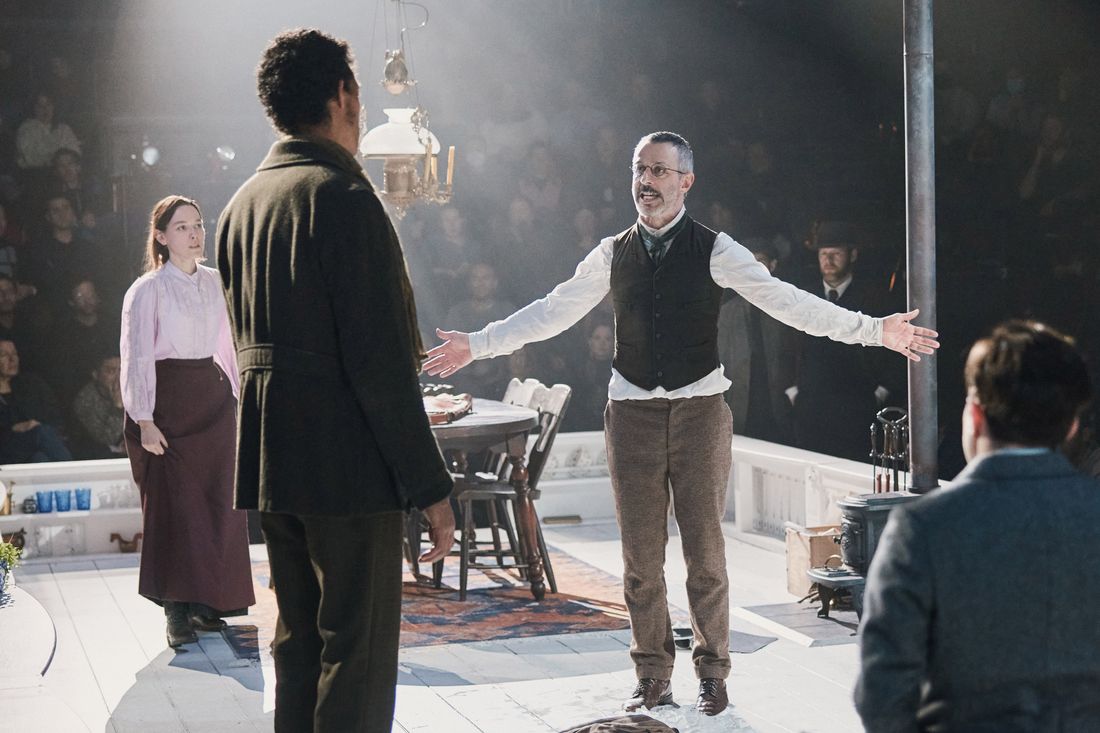
Midway through the new version of An Enemy of the People adapted and directed respectively by the power couple Amy Herzog and Sam Gold, a full bar is lowered from the ceiling. The delights of this moment are manifold: Circle in the Square has no fly space, and we’ve had no hint that the compact, alley-style set created by the design collective dots — with its many real candles and oil lamps and its simple, rustic furnishings suggesting a late-1800s Norwegian home — is hiding anything. Even as we’re enjoying the architectural surprise, the house lights pop up, a couple of bartenders enter the stage, and the actors start beckoning audience members up for a drink. The show has no official intermission, but for the next ten minutes, during this informal “pause,” we’ll be invited to line up for free aquavit, mingle with the cast as they mill easily about the stage, chat with our neighbors, listen to some Norwegian folk music (beautifully sung by Katie Broad), and perhaps even stay on the set as the show continues.
Henrik Ibsen’s play, by that moment, is headed into its fourth act, in which its besieged hero attempts to share a devastating discovery with his fellow citizens. In Herzog and Gold’s rendering, the act emerges organically out of the genial disorder of roughly 700 people jumping at the chance for free drinks. As the play recommences, the space between performers and spectators is naturally, potently blurred. We are all, always, in this together, but we’re not always made to recognize the fact.
Perhaps Herzog and Gold have had the same conversation I’ve had with so many theater folks over so many drinks: Why don’t more theaters have bars? Not “$20 for a souvenir sippy cup of wine” bars — real bars. Why don’t they stay open after the show or open before? People should want to stick around and drink and talk — why don’t we facilitate that? Or perhaps they simply saw a way to crack open Ibsen’s play and went for it. Whatever the case, the gesture is as profound as it is pleasurable. Like Arthur Miller, Ibsen was a writer of deep moral indignation — he suffered over society’s hypocrisies, our evils and our cowardice, and he wrote to get people arguing, to encourage an active reexamination of values. His plays, however, can turn stuffy and melodramatic in modern productions: living museum dioramas in which women in long skirts and men in frock coats howl about syphilis and scandal. But Herzog and Gold have cleared away any fustiness (which really lies not in Ibsen but in us) and have drawn out Enemy’s inherent muscularity.
Their two leads are also a real asset here, and not for their famous names. As the brothers locking horns at the play’s center — the principled Dr. Thomas Stockmann and the political animal Mayor Peter Stockmann — Jeremy Strong and Michael Imperioli both bring a vigorous contemporary affect to the material. You can feel the toughness and tension, the roiling potential energy, of their more modern characters flexing within David Zinn’s costumes, which land us softly in the 1880s without feeling rigid in their period accuracy. Just as Michael Shannon and Paul Sparks did with Waiting for Godot last fall, they find a uniquely American tone that, rather than creating dissonance, only highlights the play’s fundamental solidity. There’s a casual quality to Imperioli’s performance that becomes more and more insidious as the show goes on. His Peter Stockmann doesn’t like to raise his voice. He’s a man who wears power easily — who will shift and evade instinctively, nimbly, like a rodent or an insect, in order to maintain and increase it.
By contrast, the most striking element of Strong’s Dr. Stockmann is, perhaps surprisingly, not his forcefulness but his guilelessness. This isn’t a man who drives onto the stage in a bullheaded fury, already prepared to fight to the death for what’s right. This is an earnest, grounded, good-hearted scientist — a guy who loves his kids, is still grieving his beloved wife, has a sense of humor and a taste for hot toddies, and starts from a place of trust in his friends and hopefulness about human nature. “What is there to say?” he asks his houseguests after revealing his discovery. The people, he’s confident, will “be glad to know the truth.”
What Dr. Stockmann has discovered is that their town’s much-celebrated public baths — a health resort that forms the basis of the local economy — are “utterly contaminated.” Pollution from nearby tanneries has seeped into the groundwater, flooding the baths with harmful bacteria. “It’s a massive health risk,” says Thomas, who intends to share the news with his neighbors — after which, naturally, the right steps will be taken. But he soon finds himself receiving his own brutal education in just how easily the truth can be beaten, tortured, and buried when it threatens those with money, power, and position.
As Thomas is cruelly awakened from his intrinsic faith in goodness and justice, An Enemy of the People takes on an allegorical quality. Like Everyman or Job, Dr. Stockmann is gradually abandoned and anathematized by almost everyone he trusts. Even the seemingly radical Hovstad (Caleb Eberhardt, compellingly torn between sincerity and self-interest) and Billing (Matthew August Jeffers) — who publish the local liberal newspaper — soon curdle toward him like cream left in the sun. Their associate, the local printer Aslaksen (expertly obsequious in the hands of Thomas Jay Ryan), has much to do with encouraging their treachery. “I always aim for moderation,” says Aslaksen, with a half-smile oily enough to fry potatoes. Herzog doesn’t need to hammer home the twinges of resonance in Ibsen’s text. We can see with painful clarity the fact that the greatest enemies to truth and right action won’t just come spouting hatred and wielding a pitchfork or a gun. They’ll arrive in nice suits, appealing to reason and civility, and they’ll wedge a foot in the door to let in the darkness, all while shaking their heads and wringing their hands, because isn’t it just too bad?
Dr. Stockmann’s tragedy is that of the accidental activist. If his story had been written in the 1940s, its author would have been Frank Capra and its star Jimmy Stewart. “You know I don’t like to get involved in politics,” Thomas tells Hovstad early on, showing much more diffidence than the fiery, sarcastic editor. Later, Thomas’s brother looks at him with a kind of confused disgust: “You have no political insincts at all,” says Peter. He’s right. It’s this very lack that will catapult Dr. Stockmann into the fray. His instinct is simply to identify what’s right and, once he’s found it, to hold on — even to the point of clinging, like a storm-battered, half-drowned sailor, to a broken splinter of mast. As the public forum of the play’s fourth act advances, Herzog’s rendering of Ibsen becomes particularly searing. “I apologize for my brother, Mr. Hovstad,” says Peter at one point his voice weary with the self-claimed victimhood of the sanctimonious. “As you see, he’s always been incapable of nuance.” As the public forum of the play’s fourth act advances, the black clouds that have been gathering start to burst. Herzog’s rendering of Ibsen is particularly searing here. In a motion to deny Thomas the right even to speak about his findings, the mayor goes on: “This is not a decision I took lightly. The freedom to speak your mind is sacrosanct in our town. But when the community is under threat, when words can cause real harm, then we must use what power we have to keep these dangerous ideas from spreading.” Herzog deserves a mini-prize for working in such a zinging use of “harm” — a word that feels, in our moment, either flogged into meaninglessness or inflated into parody. But what’s on display here isn’t just an excoriation of liberal piousness; it’s the way authoritarianism co-opts liberal diction and sets up false equivalencies in order to paint something as obviously fascistic as open censorship in seemingly reasonable terms.
As the town meeting descends into rageful rabidity, Gold stages a stark and brutal burst of violence toward Dr. Stockmann that’s even more shocking when we realize that Strong’s body — which has been out of sight and, we assume, out of the way of any actual assault — has in fact been receiving the blows aimed at it. I won’t spoil the details, and I have no question that, under Thomas Schall’s fight direction, Gold’s actors are safe, but it’s thrilling to see an American production push further both into visual metaphor and into physical courage and trust than many are ever willing to go. In the wake of this horrible moment, as the play enters its aching dénouement, both Strong and Victoria Pedretti, as his daughter, Petra, shine with a delicate new light. As Dr. Stockmann and Petra support each other (and she, it should be said, has been as morally unwavering as her father while also working a day job, feeding everyone, taking care of her little brother, and fending off the advances of multiple men), Herzog takes some of her greatest liberties with Ibsen’s script — great in both senses of the word. Gone is Ibsen’s original ending, in which Dr. Stockmann proudly declares that “the strongest man in the world is he who stands most alone.” Herzog finds something much deeper, much more tender, and much less individualistic. For her and Gold, Thomas’s devastation becomes the kind of fertile terrain that exists after a forest fire: a wrecked landscape in which the seeds of possibility can and must be sown. In the words of Captain Horster (Alan Trong), the only friend who sticks by Petra and Thomas throughout, “There’s something to be said for … being at the very bottom. You know where the ground is.”
An Enemy of the People is at Circle in the Square Theatre through June 16.


